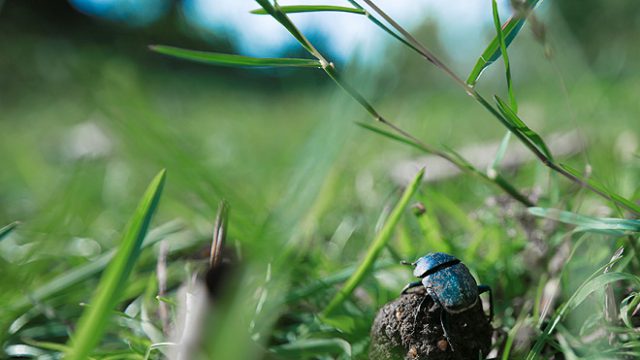The eastern Vidharba landscape turns a rich green during the monsoons, and for the tiger reserves situated within its range, the green turns a deeper shade. I took good care to ensure that I was properly dressed for the occasion—a full shirt to cover my arms, a pair of trousers and a pair of flimsy shoes. Mind you, my socks weren’t an intentional omission but a callous case of contempt for the wild, one that would come back to literally bite me.
Fully geared up for the walk, I felt the moisture-laden forests of Tadoba beckon. They were once again brimming with life after a punishingly blistering summer. At this point you’re perhaps wondering why I took such pains to clothe myself for a regular jungle safari. Well, the answer is that I didn’t. This time, there would be no trustworthy services of a gypsy to keep me out of harm’s way. I had chosen to scout the forest on foot—armed with nothing but my wits and the reassuring company of my guide.

Surprisingly, the first obstacle we had trouble negotiating wasn’t the dense monsoon foliage. It was a profusion of cobwebs, slowing us down by forcing us to constantly duck as we attempted to steer clear of the delicate strands outlining the web. In the middle of these sat enormous giant-wood spiders, patiently waiting for an unwary critter to get entangled and become dinner. Few know about the spider’s appetite for birds (yes you heard that right), and being no arachnologist in the making, I was more than pleased to give the eight-legged giants a wide berth.
Cutting through the heady fragrance of the rejuvenated forest was a sharp smell of putrefying meat, instantly putting us on guard. Had we chanced upon a kill? Asking us to stay put, our guide went ahead to identify the source of the stench. He was hardly a few paces ahead of us when something growled at him from the bush! But weirdly, instead of having my heart in my mouth, I heaved a heavy sigh of relief. The tenor of the growl had given the guardian of the kill away—a stray dog. We resumed our walk, leaving the famished dog to feast on the decaying remains of a goat that had perished naturally.
A couple of minutes later, we came across the remains of a dead cow. It was a macabre sight—it isn’t everyday that you see the decomposed digestive waste from a cow’s torn intestine. The carcass was certainly a leftover from an incident of cattle-lifting, for which a desperate, starving tiger was responsible. Needlessly to say, these graphic details had further enlivened the walk for us. Tadoba’s tigers might have retreated into the inner precincts of the park with the advent of the monsoons, but the mangled remains of the cow’s guts had brought them to the fore of our consciousness.

My fondness for bushwalking stems mainly from the intimate taste of immersing myself in the forest; a sense of vulnerability envelops me and I don’t feel like a foreigner in an exotic land anymore. Walks also happen to be great levellers: on coming across a semi-obliterated termite mound ravaged by the wrath of a gluttonous sloth bear, it dawned on me that just like the docile inhabitants of the mound, I too wouldn’t be able to withstand the depredations of a feisty bear. Another pleasurable aspect of a walk is that it teaches me how to track. It’s a pleasure to learn to decipher the numerous signs left behind by the forest’s umpteen inhabitants. When we came across a distinctive trail of paw-prints, I had no clue about the identity of its maker, till our guide revealed that the tracks had been made by a porcupine. Never having seen the creature or its spoor in the jungle before, I was thoroughly delighted to have added a new nugget of information to my jungle lore.
Probably the most rewarding facet of jungle-walking is that it forces you to look down! The forest floor is a perilous place, full of all sorts of creepy crawlies and slithering serpents. One misstep could result in nasty consequences, and that’s precisely why one needs to scan the ground ahead of him from time to time to steer clear of such hazards. However, it’s not just a question of safety; looking down reveals the little gems of the forest floor, that’s an impossible proposition while on a safari.

A dung beetle, with is golf-ball- sized load, was one such sight. Don’t let its unsavory association with cattle droppings spurn your interest in this creature. Capable of maneuvering a ball of dung that’s 250 times its own weight, it is truly a creature to marvel at—and pound for pound the strongest creature in the animal world! If you thought that was the only mind-boggling credential it had, here’s another: the dung beetle has an in-built navigation system, based on its reading of celestial objects, to find its way back home! Although we’d spotted our beetle under a hot midday sun, we did catch a slight glimpse of the beetle’s navigational genius when it just about averted an impending crisis by opting for a detour—in the nick of time—around a puddle that it was headed towards. What an excruciatingly strenuous existence, I thought to myself.
I, on the other hand, was already reeling under the weight of my friend’s camera bag. Thankfully, the dung-beetle’s tenacity had rubbed-off on me; I trudged on to complete the grueling 11-km trek. And just like the hardy beetle, I too would be returning home with a prodigious load of supplies, comprising of all memories I had amassed over the course of my walk, and would greatly rely on, to keep my dreary, urban soul afloat, till my next foray into the wild.




